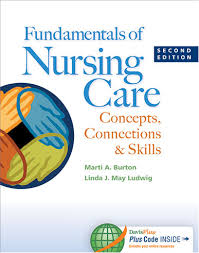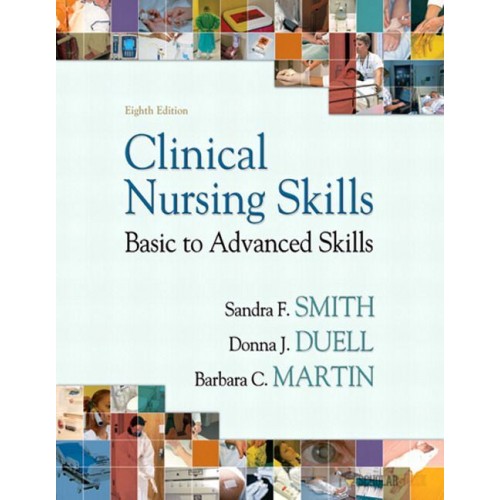Test Bank Fundamentals Nursing Care Skills 2nd Edition Ludwig Burton
$35.00
Test Bank Fundamentals Nursing Care Skills 2nd Edition Ludwig Burton
Get your degree with ease by using our files. We do not keep any logs and we do not log any information. What does this mean for you? This means, your order is completely anonymous and confidential. Part of our service allows you to purchase these files without anyone else knowing. There is no risk and you have nothing to lose. If you are using this very textin school right now, then you will need this nursing test bank to learn important core knowledge so you can be the ultimate nurse. Add this product to your cart and checkout to receive the download for your nursing test bank for Test Bank Fundamentals Nursing Care Skills 2nd Edition Ludwig Burton
Do you have any questions? Would you like a sample sent to you? Just send us an email at support@testbankteam.net (no spaces). We will respond as soon as possible.
== SAMPLE ==
Chapter 2. Health Care Delivery and Economics
Multiple Choice
Identify the choice that best completes the statement or answers the question.
____ 1. The federal government’s health insurance program for people older than 65 years of age or those with certain disabilities or conditions is known as
A. Medicaid.
B. Medicare.
C. Social Security.
D. Private insurance.
____ 2. The nurse recognizes that a system of health care delivery aimed at managing the cost and quality of access to health care is known as
A. Medicaid.
B. Medicare.
C. Managed care.
D. Private insurance.
____ 3. The student nurse is caring for a patient who will be transferred to a skilled nursing facility (SNF). When educating the student nurse about an SNF, the nurse recognizes that further instruction is needed when the student nurse states,
A. “Medicare will most likely pay for my patient’s care at the SNF.”
B. “I hope that my patient gets to return home after going to the SNF.”
C. “My patient will never get to go home again if he’s transferred to an SNF.”
D. “My patient will receive skilled nursing care such as physical therapy as needed.”
____ 4. The student nurse is caring for a patient who will be transferred to a skilled nursing facility (SNF). When collaborating with the case manager about transferring the patient to an SNF, the case manager tells the student that the SNF will most likely be covered by Medicare if
A. The patient stays longer than 100 days per year.
B. The patient enters the SNF within 60 days of a hospitalization.
C. The patient has been hospitalized for at least 1 day prior to admission.
D. The patient makes regular progress as documented by the medical professionals.
____ 5. A student nurse is caring for a patient at a rehabilitation facility. The student nurse educates the patient about the rehabilitation facility. The nurse intervenes when the student states,
A. “You will receive intense therapy services while you’re here.”
B. “You must participate in at least 6 hours of therapy each day.”
C. “You will be seen by a physician who specializes in rehabilitation.”
D. “If you get sick while you’re here, we can transfer you to the hospital.”
____ 6. A patient is considering moving to an assisted-living facility. When providing education about an assisted-living facility, the nurse states,
A. “An assisted-living facility provides a home-like atmosphere.”
B. “An assisted-living facility provides a hospital-like atmosphere.”
C. “Your physician will make daily visits while you’re at an assisted-living facility.”
D. “You should move to an assisted-living facility when you’re no longer independent.”
____ 7. A nursing instructor is teaching a group of nursing students about which communicable diseases should be reported to the health department. The nursing instructor recognizes that further instruction is needed when a nursing student states,
A. “Syphilis should be reported to the health department.”
B. “Hepatitis should be reported to the health department.”
C. “Influenza should be reported to the health department.”
D. “Emphysema should be reported to the health department.”
____ 8. When working in a health clinic, the nurse recognizes that a communicable disease that should be reported to the health department is
A. Gonorrhea.
B. Grave’s disease.
C. Diabetes mellitus.
D. Cushing’s syndrome.
____ 9. The home health care nurse delegates to the home health care aide the responsibility of
A. Administering tap water enemas until clear.
B. Transporting the patient to the physician’s office.
C. Teaching the patient how to turn, cough, and deep breathe.
D. Administering nitroglycerin when the patient experiences angina.
____ 10. When supervising a home health care aide, the nurse intervenes when observing the home health care aide
A. Giving the patient a back massage.
B. Preparing the patient’s favorite meal.
C. Transporting the patient to the grocery store.
D. Teaching the patient how to check his or her apical pulse.
____ 11. When supervising a home health care aide, the nurse intervenes when observing the home health care aide
A. Braiding a patient’s hair.
B. Driving a patient to church.
C. Giving a patient a bed bath.
D. Teaching a patient about nutrition.
____ 12. A hospice nurse provides an in-service about the purpose of hospice to a group of nursing students. The hospice nurse tells the students that the National Hospice Organization defines hospice as a
A. Nurse-directed physician-coordinated program.
B. Medically directed nurse-coordinated program.
C. Nurse-directed psychiatrist-coordinated program.
D. Medically directed psychologist-coordinated program.
____ 13. A patient’s spouse asks the nurse about hospice. The nurse educates that hospice is
A. A service that provides care to the terminally ill patient only.
B. Warranted when the patient still seeks a cure for his or her terminal illness.
C. A program that focuses on palliative treatment and emotional support.
D. Appropriate when the patient is expected to live for fewer than 9 months.
____ 14. The nurse is supervising a certified nursing assistant (CNA). The nurse intervenes when the CNA asks a patient,
A. “What is your pain level?”
B. “Would you like a snack?”
C. “When would you like your bath?”
D. “Is it okay if I take your vital signs?”
____ 15. A nursing instructor educates a group of nursing students about client-centered care. The nursing instructor recognizes that further teaching is needed when a nursing student states,
A. “Client-centered care fosters a feeling of dependence.”
B. “Client-centered care is often seen in a rehabilitation setting.”
C. “Client-centered care empowers the patient to manage his or her care.”
D. “Client-centered care empowers the patient to take control of his or her care.”
____ 16. A nurse demonstrates understanding of client-centered care when
A. Managing every aspect of the patient’s care.
B. Performing as many tasks as possible for the patient.
C. Performing all activities of daily living for the patient.
D. Limiting the patient’s decision making to alleviate anxiety.
____ 17. A nurse is working in a critical care unit where the focus is on primary-care nursing. The nurse demonstrates understanding of primary-care nursing when
A. Asking the unlicensed assistant to give a bed bath.
B. Asking another nurse to call the physician for orders.
C. Providing all aspects of nursing care for assigned patients.
D. Instructing the nursing assistant to take the patient’s vital signs.
____ 18. A nursing instructor is educating a group of nursing students about primary-care nursing. The nursing instructor teaches that in primary-care nursing
A. A nursing assistant is assigned to give baths to each patient on the unit.
B. Each patient has a nursing assistant to assist with feeding and linen changes.
C. One nurse is responsible for all aspects of nursing care for an assigned patient.
D. Two nurses are responsible for all aspects of nursing care for an assigned patient.
____ 19. A nurse is educating a student nurse about primary-care nursing. The nurse recognizes that additional teaching is warranted when the student nurse states,
A. “In primary-care nursing, the nurse must be able to work quickly under stress.”
B. “In primary-care nursing, the nurse must be able to work efficiently in a crisis.”
C. “In primary-care nursing, the nurse must be able to assess the patient carefully.”
D. “In primary-care nursing, the nurse must supervise the nursing assistants closely.”
____ 20. The student nurse is caring for a patient who is covered by Medicaid. When speaking with the case manager about Medicaid, the case manager tells the student nurse that Medicaid
A. Offers the same benefits in every state.
B. Is funded by the city health department.
C. Is a county government matching funding program.
D. Offers assistance to pregnant impoverished women.
____ 21. A case manager is giving an in-service about public health insurance to a group of nursing students. The case manager recognizes that additional instruction is warranted when a nursing student states,
A. “Aetna is an example of public health insurance.”
B. “Medicaid is an example of public health insurance.”
C. “Medicare is an example of public health insurance.”
D. “Indian Health Service is an example of public health insurance.”
____ 22. When teaching a class of nursing students about advanced practice nursing, the nursing instructor states,
A. “A nurse practitioner cannot diagnose illnesses.”
B. “A nurse practitioner is not able to prescribe medications.”
C. “A nurse practitioner must be supervised by a registered nurse.”
D. “A nurse practitioner can diagnose illnesses within his or her scope of practice.”
____ 23. When teaching a student nurse about the scope of practice for the licensed practical/vocational nurse (LPN or LVN), the nursing instructor notes that additional teaching is needed when the student nurse states,
A. “The LPN or LVN can practice independently.”
B. “The LPN or LVN can practice under the supervision of a dentist.”
C. “The LPN or LVN can practice under the supervision of a physician.”
D. “The LPN or LVN can practice under the supervision of a registered nurse.”
____ 24. The nurse is caring for a patient with increasing dyspnea. The nurse recognizes that the most appropriate health care worker to collaborate with is the
A. Physical therapist.
B. Respiratory therapist.
C. Occupational therapist.
D. Speech and language therapist.
____ 25. The nurse is caring for a patient with a nursing diagnosis of impaired physical mobility. The nurse recognizes that the most appropriate health care worker to collaborate with is the
A. Physical therapist.
B. Respiratory therapist.
C. Occupational therapist.
D. Speech and language therapist.
Chapter 2. Health Care Delivery and Economics
Answer Section
MULTIPLE CHOICE
1. ANS: B
Feedback
A Medicare is the federal government’s health insurance program for people older than 65 years of age or those with certain disabilities or conditions.
B Medicare is the federal government’s health insurance program for people older than 65 years of age or those with certain disabilities or conditions. Chapter Objective: Contrast Medicare and Medicaid.
C Medicare is the federal government’s health insurance program for people older than 65 years of age or those with certain disabilities or conditions.
D Medicare is the federal government’s health insurance program for people older than 65 years of age or those with certain disabilities or conditions.
PTS: 1 REF: Chapter: 2 | Page: 2 OBJ: Chapter Objective: 2-6
KEY: Content Area: Medicare | Integrated Process: Teaching and Learning | Client Need: Health Promotion and Maintenance | Cognitive Level: Comprehension
2. ANS: C
Feedback
A Managed care is defined as a system of health care delivery aimed at managing the cost and quality of access to health care.
B Managed care is defined as a system of health care delivery aimed at managing the cost and quality of access to health care.
C Managed care is defined as a system of health care delivery aimed at managing the cost and quality of access to health care. Chapter Objective: Describe various types of private health insurance.
D Managed care is defined as a system of health care delivery aimed at managing the cost and quality of access to health care.
PTS: 1 REF: Chapter: 2 | Page: 2 OBJ: Chapter Objective: 2-7
KEY: Content Area: Managed Care | Integrated Process: Teaching and Learning | Client Need: Health Promotion and Maintenance | Cognitive Level: Application
3. ANS: C
Feedback
A An SNF level of care is usually covered by Medicare and most private insurances.
B Patients may stay in an SNF for a few days or as long as 100 days, but they eventually move to a rehabilitation facility, nursing home, or home setting.
C Patients may stay in an SNF for a few days or as long as 100 days, but they eventually move to a rehabilitation facility, nursing home, or home setting. Chapter Objective: Describe inpatient health care settings and their services.
D SNF care consists of skilled nursing care and physical, occupational, and speech therapy as needed.
PTS: 1 REF: Chapter: 2 | Page: 5 OBJ: Chapter Objective: 2-3
KEY: Content Area: Skilled Nursing Facility | Integrated Process: Teaching and Learning | Client Need: Health Promotion and Maintenance | Cognitive Level: Application
4. ANS: D
Feedback
A An SNF level of care is usually covered by Medicare and most private insurances, but there are certain requirements: for example, there is a 100-day stay maximum per year related to any one hospitalization and diagnosis.
B An SNF level of care is usually covered by Medicare and most private insurances, but there are certain requirements: for example, the patient must enter the nursing home within 30 days of a hospitalization.
C An SNF level of care is usually covered by Medicare and most private insurances, but there are certain requirements: for example, the patient must have been hospitalized for at least 3 days prior to admission.
D An SNF level of care is usually covered by Medicare and most private insurances, but there are certain requirements: for example, the patient must be making regular progress as documented by the medical professionals. Chapter Objective: Describe inpatient health care settings and their services. Chapter Objective: Contrast Medicare and Medicaid.
PTS: 1 REF: Chapter: 2 | Page: 5
OBJ: Chapter Objectives: 2-3| Chapter Objectives: 2-6
KEY: Content Area: Skilled Nursing Facility | Integrated Process: Teaching and Learning | Client Need: Health Promotion and Maintenance | Cognitive Level: Analysis
5. ANS: B
Feedback
A Rehabilitation is a level of care in which the patient can receive intense physical, occupational, and speech therapy services.
B As a rule of thumb, the patient must be capable of participating in at least 3 hours of therapy a day to be admitted to a rehabilitation facility. Chapter Objective: Explain two types of rehabilitation services.
C A physician specialist in physical medicine and rehabilitation oversees the patient’s care during his or her stay.
D If the patient becomes ill or has other medical problems while in rehabilitation, he or she may be transferred back to an acute care hospital.
PTS: 1 REF: Chapter: 2 | Page: 5 OBJ: Chapter Objective: 2-8
KEY: Content Area: Rehabilitation Facility | Integrated Process: Teaching and Learning | Client Need: Health Promotion and Maintenance | Cognitive Level: Analysis
6. ANS: A
Feedback
A Assisted-living facilities provide relatively independent seniors with assistance and limited health care services in a home-like atmosphere. Chapter Objective: Describe inpatient health care settings and their services.
B Assisted-living facilities provide relatively independent seniors with assistance and limited health care services in a home-like atmosphere (not a hospital-like atmosphere).
C Assisted-living facilities provide relatively independent seniors with assistance and limited health care services (not daily physician visits) in a home-like atmosphere.
D Assisted-living facilities provide relatively independent seniors with assistance and limited health care services in a home-like atmosphere.
PTS: 1 REF: Chapter: 2 | Page: 5 OBJ: Chapter Objective: 2-3
KEY: Content Area: Assisted-Living Facility | Integrated Process: Teaching and Learning | Client Need: Health Promotion and Maintenance | Cognitive Level: Application
7. ANS: D
Feedback
A Health departments are responsible for the tracking and treatment of certain communicable diseases, which are diseases that are transmitted through direct contact with an infected individual or indirect contact through a carrier. Some examples of communicable diseases that health departments treat and track include tuberculosis, sexually transmitted diseases, measles, mumps, rubella, hepatitis, influenza, and certain viruses.
B Health departments are responsible for the tracking and treatment of certain communicable diseases, which are diseases that are transmitted through direct contact with an infected individual or indirect contact through a carrier. Some examples of communicable diseases that health departments treat and track include tuberculosis, sexually transmitted diseases, measles, mumps, rubella, hepatitis, influenza, and certain viruses.
C Health departments are responsible for the tracking and treatment of certain communicable diseases, which are diseases that are transmitted through direct contact with an infected individual or indirect contact through a carrier. Some examples of communicable diseases that health departments treat and track include tuberculosis, sexually transmitted diseases, measles, mumps, rubella, hepatitis, influenza, and certain viruses.
D Health departments are responsible for the tracking and treatment of certain communicable diseases, which are diseases that are transmitted through direct contact with an infected individual or indirect contact through a carrier. Some examples of communicable diseases that health departments treat and track include tuberculosis, sexually transmitted diseases, measles, mumps, rubella, hepatitis, influenza, and certain viruses. Emphysema is not an example of a communicable disease treated and tracked by the health department. Chapter Objective: Describe outpatient health care settings and their services.
PTS: 1 REF: Chapter: 2 | Page: 7 OBJ: Chapter Objective: 2-4
KEY: Content Area: Communicable Diseases | Integrated Process: Teaching and Learning | Client Need: Health Promotion and Maintenance | Cognitive Level: Application
8. ANS: A
Feedback
A Health departments are responsible for the tracking and treatment of certain communicable diseases, which are diseases that are transmitted through direct contact with an infected individual or indirect contact through a carrier. Some examples of communicable diseases that health departments treat and track include tuberculosis, sexually transmitted diseases (such as gonorrhea), measles, mumps, rubella, hepatitis, influenza, and certain viruses. Chapter Objective: Describe outpatient health care settings and their services.
B Health departments are responsible for the tracking and treatment of certain communicable diseases, which are diseases that are transmitted through direct contact with an infected individual or indirect contact through a carrier. Some examples of communicable diseases that health departments treat and track include tuberculosis, sexually transmitted diseases, measles, mumps, rubella, hepatitis, influenza, and certain viruses. Grave’s disease (an endocrine disorder) is not an example of a communicable disease treated and tracked by the health department.
C Health departments are responsible for the tracking and treatment of certain communicable diseases, which are diseases that are transmitted through direct contact with an infected individual or indirect contact through a carrier. Some examples of communicable diseases that health departments treat and track include tuberculosis, sexually transmitted diseases, measles, mumps, rubella, hepatitis, influenza, and certain viruses. Diabetes mellitus (an endocrine disorder) is not an example of a communicable disease treated and tracked by the health department.
D Health departments are responsible for the tracking and treatment of certain communicable diseases, which are diseases that are transmitted through direct contact with an infected individual or indirect contact through a carrier. Some examples of communicable diseases that health departments treat and track include tuberculosis, sexually transmitted diseases, measles, mumps, rubella, hepatitis, influenza, and certain viruses. Cushing’s syndrome (an endocrine disorder) is not an example of a communicable disease treated and tracked by the health department.
PTS: 1 REF: Chapter: 2 | Page: 7 OBJ: Chapter Objective: 2-4
KEY: Content Area: Communicable Diseases | Integrated Process: Nursing Process/Implementation | Client Need: Health Promotion and Maintenance | Cognitive Level: Application
9. ANS: B
Feedback
A Specially trained nursing assistants, or home health care aides, provide nonskilled services such as assistance with bathing and grooming, housekeeping, transportation, and food preparation and delivery. Administering tap water enemas until clear is a nursing skill.
B Specially trained nursing assistants, or home health care aides, provide nonskilled services such as assistance with bathing and grooming, housekeeping, transportation (including transporting the patient to the physician’s office), and food preparation and delivery. Chapter Objective: Describe outpatient health care settings and their services.
C Specially trained nursing assistants, or home health care aides, provide nonskilled services such as assistance with bathing and grooming, housekeeping, transportation, and food preparation and delivery. Teaching a patient how to turn, cough, and deep breathe is a nursing skill.
D Specially trained nursing assistants, or home health care aides, provide nonskilled services such as assistance with bathing and grooming, housekeeping, transportation, and food preparation and delivery. Administering nitroglycerin is a nursing skill.
PTS: 1 REF: Chapter: 2 | Page: 21 OBJ: Chapter Objective: 2-4
KEY: Content Area: Delegation | Integrated Process: Nursing Process/Implementation | Client Need: Health Promotion and Maintenance | Cognitive Level: Analysis
10. ANS: D
Feedback
A Specially trained nursing assistants, or home health care aides, provide nonskilled services such as assistance with bathing and grooming, housekeeping, transportation, and food preparation and delivery. Giving the patient a back massage is a nonskilled service that can be done when bathing the patient.
B Specially trained nursing assistants, or home health care aides, provide nonskilled services such as assistance with bathing and grooming, housekeeping, transportation and food preparation (including preparing the patient’s favorite meal) and delivery.
C Specially trained nursing assistants, or home health care aides, provide nonskilled services such as assistance with bathing and grooming, housekeeping, transportation (including transporting the patient to the grocery store), and food preparation and delivery.
D Specially trained nursing assistants, or home health care aides, provide nonskilled services such as assistance with bathing and grooming, housekeeping, transportation, and food preparation and delivery. Teaching the patient how to check his or her apical pulse is a nursing skill. Chapter Objective: Describe outpatient health care settings and their services.
PTS: 1 REF: Chapter: 2 | Page: 21 OBJ: Chapter Objective: 2-4
KEY: Content Area: Supervision | Integrated Process: Nursing Process/Implementation | Client Need: Health Promotion and Maintenance | Cognitive Level: Analysis
11. ANS: D
Feedback
A Specially trained nursing assistants, or home health care aides, provide nonskilled services such as assistance with bathing and grooming (such as braiding a patient’s hair), housekeeping, transportation, and food preparation and delivery.
B Specially trained nursing assistants, or home health care aides, provide nonskilled services such as assistance with bathing and grooming, housekeeping, transportation (including driving a patient to church), and food preparation and delivery.
C Specially trained nursing assistants, or home health care aides, provide nonskilled services such as assistance with bathing (including giving a bed bath) and grooming, housekeeping, transportation, and food preparation and delivery.
D Specially trained nursing assistants, or home health care aides, provide nonskilled services such as assistance with bathing and grooming, housekeeping, transportation, and food preparation and delivery. Teaching a patient about nutrition is a nursing skill. Chapter Objective: Describe outpatient health care settings and their services.
PTS: 1 REF: Chapter: 2 | Page: 21 OBJ: Chapter Objective: 2-4
KEY: Content Area: Supervision | Integrated Process: Nursing Process/Implementation | Client Need: Health Promotion and Maintenance | Cognitive Level: Analysis
12. ANS: B
Feedback
A The National Hospice Organization defines hospice as “a medically directed nurse-coordinated program providing a continuum of home and inpatient care for the terminally ill patient and family.”
B The National Hospice Organization defines hospice as “a medically directed nurse-coordinated program providing a continuum of home and inpatient care for the terminally ill patient and family.” Chapter Objective: Describe outpatient health care settings and their services.
C The National Hospice Organization defines hospice as “a medically directed nurse-coordinated program providing a continuum of home and inpatient care for the terminally ill patient and family.”
D The National Hospice Organization defines hospice as “a medically directed nurse-coordinated program providing a continuum of home and inpatient care for the terminally ill patient and family.”
PTS: 1 REF: Chapter: 2 | Page: 22 OBJ: Chapter Objective: 2-4
KEY: Content Area: Hospice | Integrated Process: Teaching and Learning | Client Need: Psychosocial Integrity | Cognitive Level: Application
13. ANS: C
Feedback
A The National Hospice Organization defines hospice as “a medically directed nurse-coordinated program providing a continuum of home and inpatient care for the terminally ill patient and family.”
B The appropriate time for hospice care is when the patient is no longer seeking treatment to arrest or cure the disease and is expected to live for 6 months or fewer.
C Hospice services include management of the patient’s pain and symptoms (palliative treatment), emotional support to the patient and family, medications, medical supplies and equipment, caregiver instructions and support, coordination of all health care services, and grief support for surviving loved ones and friends. Chapter Objective: Describe outpatient health care settings and their services.
D The appropriate time for hospice care is when the patient is no longer seeking treatment to arrest or cure the disease and is expected to live for 6 months or fewer.
PTS: 1 REF: Chapter: 2 | Page: 22 OBJ: Chapter Objective: 2-4
KEY: Content Area: Hospice | Integrated Process: Teaching and Learning | Client Need: Psychosocial Integrity | Cognitive Level: Analysis
14. ANS: A
Feedback
A The LPN/LVN might be responsible for administering medications to all of the patients as well as performing any treatments, such as dressing changes, assessing the patient for any changes from baseline, evaluating pain levels (such as asking the patient, “What is your pain level?”) and medicating appropriately, and providing patient teaching. The unlicensed assistant or certified nursing assistant might be responsible for helping each patient bathe and dress in a clean gown, changing sheets on the beds, assisting patients to the bathroom, and taking routine vital signs. Chapter Objective: Describe members of the health care team and their functions.
B The LPN/LVN might be responsible for administering medications to all of the patients as well as performing any treatments, such as dressing changes, assessing the patient for any changes from baseline, evaluating pain levels and medicating appropriately, and providing patient teaching. The unlicensed assistant or certified nursing assistant might be responsible for helping each patient bathe and dress in a clean gown, changing sheets on the beds, assisting patients to the bathroom, and taking routine vital signs.
C The LPN/LVN might be responsible for administering medications to all of the patients as well as performing any treatments, such as dressing changes, assessing the patient for any changes from baseline, evaluating pain levels and medicating appropriately, and providing patient teaching. The unlicensed assistant or certified nursing assistant might be responsible for helping each patient bathe and dress in a clean gown, changing sheets on the beds, assisting patients to the bathroom, and taking routine vital signs.
D The LPN/LVN might be responsible for administering medications to all of the patients as well as performing any treatments, such as dressing changes, assessing the patient for any changes from baseline, evaluating pain levels and medicating appropriately, and providing patient teaching. The unlicensed assistant or certified nursing assistant might be responsible for helping each patient bathe and dress in a clean gown, changing sheets on the beds, assisting patients to the bathroom, and taking routine vital signs.
PTS: 1 REF: Chapter: 2 | Page: 22 OBJ: Chapter Objective: 2-2
KEY: Content Area: Scope of Practice | Integrated Process: Nursing Process/Implementation | Client Need: Safe and Effective Care Environment | Cognitive Level: Analysis
15. ANS: A
Feedback
A Client-centered care allows the patient to achieve independence within the limits of his or her disability by permitting the patient to have a voice in his or her rehabilitation, schedule, goals, and method of attaining those goals. Chapter Objective: Distinguish between types of nursing care delivery systems.
B Client-centered care is often seen in a rehabilitation setting.
C Client-centered care empowers the patient to take control of and manage his or her care.
D Client-centered care empowers the patient to take control of and manage his or her care.
PTS: 1 REF: Chapter: 2 | Page: 22 OBJ: Chapter Objective: 2-5
KEY: Content Area: Client-Centered Care | Integrated Process: Teaching and Learning | Client Need: Safe and Effective Care Environment | Cognitive Level: Analysis
16. ANS: B
Feedback
A Client-centered care empowers the patient to take control of and manage his or her care.
B In client-centered care, one goal is to provide care as soon as it is needed instead of having to wait for people from different departments to arrive. Health care workers are cross-trained to perform as many tasks as possible for each patient. Chapter Objective: Distinguish between types of nursing care delivery systems.
C Client-centered care empowers the patient to take control of and manage his or her care.
D Client-centered care allows the patient to achieve independence within the limits of his or her disability by permitting the patient to have a voice in his or her rehabilitation, schedule, goals, and method of attaining those goals.
PTS: 1 REF: Chapter: 2 | Page: 22 OBJ: Chapter Objective: 2-5
KEY: Content Area: Client-Centered Care | Integrated Process: Nursing Process/Implementation | Client Need: Health Promotion and Maintenance | Cognitive Level: Analysis
17. ANS: C
Feedback
A In primary-care nursing, one nurse is responsible for all aspects of nursing care for his or her assigned patients. This means that there is no unlicensed assistant or nursing assistant who takes vital signs, no other nurse to call the physician or take orders, and no one else who bathes the patient or changes the bed.
B In primary-care nursing, one nurse is responsible for all aspects of nursing care for his or her assigned patients. This means that there is no unlicensed assistant or nursing assistant who takes vital signs, no other nurse to call the physician or take orders, and no one else who bathes the patient or changes the bed.
C In primary-care nursing, one nurse is responsible for all aspects of nursing care for his or her assigned patients. This means that there is no unlicensed assistant or nursing assistant who takes vital signs, no other nurse to call the physician or take orders, and no one else who bathes the patient or changes the bed. Chapter Objective: Distinguish between types of nursing care delivery systems.
D In primary-care nursing, one nurse is responsible for all aspects of nursing care for his or her assigned patients. This means that there is no unlicensed assistant or nursing assistant who takes vital signs, no other nurse to call the physician or take orders, and no one else who bathes the patient or changes the bed.
PTS: 1 REF: Chapter: 2 | Page: 23 OBJ: Chapter Objective: 2-5
KEY: Content Area: Primary-Care Nursing | Integrated Process: Nursing Process/Implementation | Client Need: Health Promotion and Maintenance | Cognitive Level: Analysis
18. ANS: C
Feedback
A In primary-care nursing, one nurse is responsible for all aspects of nursing care for his or her assigned patients. This means that there is no unlicensed assistant or nursing assistant who takes vital signs, no other nurse to call the physician or take orders, and no one else who bathes the patient or changes the bed.
B In primary-care nursing, one nurse is responsible for all aspects of nursing care for his or her assigned patients. This means that there is no unlicensed assistant or nursing assistant who takes vital signs, no other nurse to call the physician or take orders, and no one else who bathes the patient or changes the bed.
C In primary-care nursing, one nurse is responsible for all aspects of nursing care for his or her assigned patients. This means that there is no unlicensed assistant or nursing assistant who takes vital signs, no other nurse to call the physician or take orders, and no one else who bathes the patient or changes the bed. Chapter Objective: Distinguish between types of nursing care delivery systems.
D In primary-care nursing, one nurse is responsible for all aspects of nursing care for his or her assigned patients. This means that there is no unlicensed assistant or nursing assistant who takes vital signs, no other nurse to call the physician or take orders, and no one else who bathes the patient or changes the bed.
PTS: 1 REF: Chapter: 2 | Page: 23 OBJ: Chapter Objective: 2-5
KEY: Content Area: Primary-Care Nursing | Integrated Process: Teaching and Learning | Client Need: Health Promotion and Maintenance | Cognitive Level: Analysis
19. ANS: D
Feedback
A In primary-care nursing, the nurse must be able to work quickly and efficiently in a crisis or under stress.
B In primary-care nursing, the nurse must be able to work quickly and efficiently in a crisis or under stress.
C In primary-care nursing, the nurse must be able to assess the patient carefully, making sure to note any small change in the patient’s condition and correctly interpreting the difference.
D In primary-care nursing, one nurse is responsible for all aspects of nursing care for his or her assigned patients. This means that there is no unlicensed assistant or nursing assistant who takes vital signs, no other nurse to call the physician or take orders, and no one else who bathes the patient or changes the bed. Chapter Objective: Distinguish between types of nursing care delivery systems.
PTS: 1 REF: Chapter: 2 | Page: 23 OBJ: Chapter Objective: 2-5
KEY: Content Area: Primary-Care Nursing | Integrated Process: Teaching and Learning | Client Need: Health Promotion and Maintenance | Cognitive Level: Analysis
20. ANS: D
Feedback
A Because the state is required to set coverage policies and administer the program, Medicaid benefits are slightly different in each state.
B Medicaid is a federal-state government matching funding program.
C Medicaid is a federal-state government matching funding program.
D Medicaid offers assistance for poor and medically indigent individuals, pregnant women with an income below the poverty level, children meeting certain income-level requirements, and certain disabled individuals meeting income level requirements. Chapter Objective: Contrast Medicare and Medicaid.
PTS: 1 REF: Chapter: 2 | Page: 24 OBJ: Chapter Objective: 2-6
KEY: Content Area: Medicaid | Integrated Process: Teaching and Learning | Client Need: Health Promotion and Maintenance | Cognitive Level: Analysis
21. ANS: A
Feedback
A Public health insurance is funded by the federal or state governments, or a combination of both. It includes Medicare, Medicaid, and the Indian Health Service. Chapter Objective: Describe various types of private health insurance.
B Public health insurance is funded by the federal or state governments, or a combination of both. It includes Medicare, Medicaid, and the Indian Health Service.
C Public health insurance is funded by the federal or state governments, or a combination of both. It includes Medicare, Medicaid, and the Indian Health Service.
D Public health insurance is funded by the federal or state governments, or a combination of both. It includes Medicare, Medicaid, and the Indian Health Service.
PTS: 1 REF: Chapter: 2 | Page: 24 OBJ: Chapter Objective: 2-7
KEY: Content Area: Public Health Insurance | Integrated Process: Teaching and Learning | Client Need: Health Promotion and Maintenance | Cognitive Level: Application
22. ANS: D
Feedback
A A nurse practitioner can diagnose illnesses and prescribe medications and treatments for them.
B A nurse practitioner can diagnose illnesses and prescribe medications and treatments for them.
C A nurse practitioner is a masters-prepared registered nurse who is certified in a specific area of practice and identified with an advanced practice license.
D A nurse practitioner can diagnose illnesses and prescribe medications and treatments for them. Chapter Objective: Describe members of the health care team and their functions.
PTS: 1 REF: Chapter: 2 | Page: 17 OBJ: Chapter Objective: 2-2
KEY: Content Area: Advanced Practice Nursing | Integrated Process: Teaching and Learning | Client Need: Health Promotion and Maintenance | Cognitive Level: Analysis
23. ANS: A
Feedback
A An LPN or LVN can practice within a defined scope under the supervision of a physician, dentist, or registered nurse. Chapter Objective: Describe members of the health care team and their functions.
B An LPN or LVN can practice within a defined scope under the supervision of a physician, dentist, or registered nurse.
C An LPN or LVN can practice within a defined scope under the supervision of a physician, dentist, or registered nurse.
D An LPN or LVN can practice within a defined scope under the supervision of a physician, dentist, or registered nurse.
PTS: 1 REF: Chapter: 2 | Page: 17 OBJ: Chapter Objective: 2-2
KEY: Content Area: Supervision | Integrated Process: Teaching and Learning | Client Need: Health Promotion and Maintenance | Cognitive Level: Application
24. ANS: B
Feedback
A The physical therapist provides services to help improve or restore function and mobility, relieve pain, and prevent or limit permanent physical disabilities for patients suffering from injuries and disease.
B The respiratory therapist evaluates, treats, and cares for patients with breathing problems due to heart and lung disease. Chapter Objective: Describe members of the health care team and their functions.
C The occupational therapist assists patients with disabilities to develop, recover, or maintain their skills for daily activities and work.
D The speech and language therapist assesses, diagnoses, treats, and helps to prevent disorders related to speech, language, voice, swallowing, and fluency.
PTS: 1 REF: Chapter: 2 | Page: 17 OBJ: Chapter Objective: 2-2
KEY: Content Area: Collaborative Care | Integrated Process: Nursing Process/Implementation | Client Need: Health Promotion and Maintenance | Cognitive Level: Application
25. ANS: A
Feedback
A The physical therapist provides services to help improve or restore function and mobility, relieve pain, and prevent or limit permanent physical disabilities for patients suffering from injuries and disease. Chapter Objective: Describe members of the health care team and their functions.
B The respiratory therapist evaluates, treats, and cares for patients with breathing problems due to heart and lung disease.
C The occupational therapist assists patients with disabilities to develop, recover, or maintain their skills for daily activities and work.
D The speech and language therapist assesses, diagnoses, treats, and helps to prevent disorders related to speech, language, voice, swallowing, and fluency.
PTS: 1 REF: Chapter: 2 | Page: 17 OBJ: Chapter Objective: 2-2
KEY: Content Area: Collaborative Care | Integrated Process: Nursing Process/Implementation | Client Need: Health Promotion and Maintenance | Cognitive Level: Application












Reviews
There are no reviews yet.